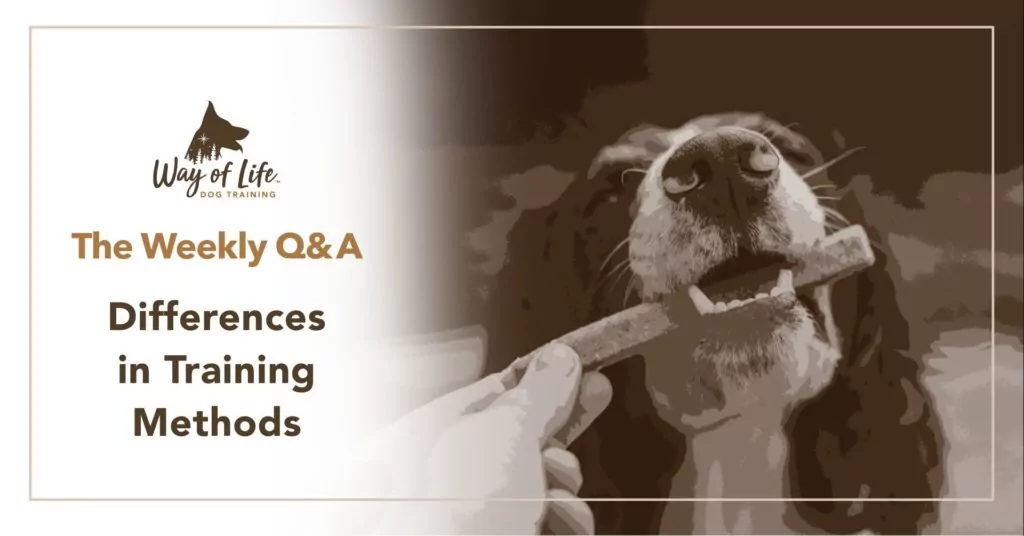
Q: We have heard that trainers differ in terms of whether they use “positive reinforcement” or whether they use force and physical punishment. Which method of training do you use?
A: I’m happy to explain the Way of Life position on the often-contentious issue of “force” versus “force-free” approaches in dog training. Usually, I tend to get this question from clients who are concerned about the use of force, punishment, and corrections. I am happy to confirm that Way of Life™ Dog Training does not condone the use of methods that involve overpowering dogs, punishing, and “dominating” them in the old school ways. We do not use or endorse any tool that would give humans an unfair advantage on the dog including prong collars, choke chains, electronic collars, head halters, and no-pull harnesses.
Even those who call themselves balanced trainers, meaning they use a balance of rewards and corrections, don’t realize what happens to dogs when they are continually corrected even if the corrections are mitigated with generous and well-timed rewards. The impact on dogs’ self-esteem and confidence is tremendous and there is no denying the alienating effect that corrections create.
With that said, we do not identify with the positive reinforcement/force-free crowd either for many reasons. Instead of examining the root cause of behavior, they think it’s enough to simply condition dogs to behave as we want them to behave. I don’t care how much food, praise, toys, and other rewards are used in the process, the over-emphasis on training and conditioning dogs is itself invasive and strips dogs of their natural ability to think. We create anxiety and reactivity when we suppress dogs’ natural intelligence with relentless behavior modification, even if we’re using carrots instead of sticks.
Moreover, there are many in the R+ community who deny the role of the human and the importance of the handler’s psychology. Some go as far as saying that we do not need to be leaders for our dogs. Not seeing dogs for the animals they are, they want them social and polite. Meanwhile, they deny that there is a place for discipline in dog training. By not disciplining or carrying themselves with the kind of authority that inspires dogs to behave, they keep dogs infantile and therefore ill behaved. And while they go on criticizing remote collars and prongs, they’re down with head halters and no-pull harnesses, tools that are as offensive as any other.
Often, clients who end up with us will have tried both ends of the spectrum only to realize that while the question of reinforcement matters, there is much more to raising a good dog. With how much focus there is on training dogs, the result is that we’re having arguments over the best way to train them, not looking at the wider context where all that training is happening. Yet, if I try to change a behavior without really working with the root cause, all I’ve done is suppress a dysfunction that will eventually manifest elsewhere.
In contrast, the Way of Life™ Method thinks of training as only one element in our overall rearing philosophy. We also consider the attitude and mindset of the owners and their relationships with their dogs. We explore the approach to managing space and boundaries inside and outside the home. We examine the owners’ understanding of socialization and how they went about it. We work with our client dog’s drives, aiming to harness and develop their innate tendencies and motivations. This is all done to produce a well behaved dog. We go beyond training dogs to creating ways of life that produce well behaved dogs. This may or may not be what you were looking for.
The aim is to mature our dogs from the state of childishness that characterizes most dogs these days to the nobility and maturity of a sound and steady dog. On occasion, discipline will be needed but let’s understand what that discipline is. It is not punishment. It is not corrections using physical force or tools that use design mechanics to subdue dogs.
So what does this discipline look like? I grab the dog’s attention, simply calling the dog to me by saying their name or asking them to come. Sometimes I grunt, as if I am clearing my throat—“ahem!” Sometimes, a simple “hey, hey!” with a sharper tone or a snapping of my fingers will do.
When we have foundations, discipline, if ever required, does not need to be harsh to be effective. When we have foundations, it matters to our dogs that we are not pleased, and they are eager to fix things. We also have the credibility to discipline, meaning dogs see our intervention as legit and it won’t hurt their feelings.